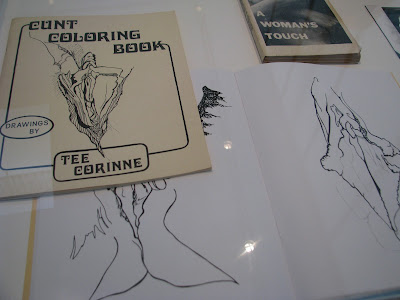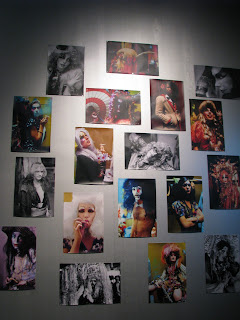Our out and out favorite is the MCA show "West of Center- Art and the Counterculture Experiment in America, 1965-1977." Maybe our current residence in the mountains of Southern Colorado, right at the center of the 1960s-70s Colorado counterculture hubbub, makes us predisposed to having tie-dyed fantasies of utopian societies swirling in our heads. But we don't think it is just that.
Co-curated by Elissa Auther (associate professor of contemporary art at th University of Colorado, Colorado Springs) and Adam Lerner (director of the MCA), "West of Center" provides an engaging and perhaps even ecstatic glimpse of the social, cultural, and artistic innovations of the couterculture movement of the 1960s and 70s. The exhibition focuses largely on countercultural experiences and production of the West, and has particular relevance to Colorado- dedicating one full gallery to Drop City (an art commune located near Trinidad) and containing many references throughout the show to various other Colorado counterculture manifestations.
 |
| Fabric-covered dome on which archival video of Drop City is projected. |
Some themes recieve more attention in the show than others, but overall the presentation is well conceived and admirably constructed. In this exhibition, construction and display are critical conveyors of content. In the Ant Farm gallery, a large inflatable into which visitors are invited to roam and onto which archival Ant Farm video clips are projected, coupled with a full sized model of an Ant Farm bus and a large layout of Ant Farm's "Truckstop Network" drawings (Click for a link to a small blurb about Ant Farm from Cabinet Magazine)lend the visitor a temporary lapse of skepticism and allow one, if only momentariy, to imagine a world in which existing infrastructure could be manipulated to truly meet the spiritual, intellectual, and aesthetic needs of the people.
 |
| Photo from inside the inflatable. (I don't know why the hell I am flapping my arms around like that, but this was the only picture that turned out.) |
 |
| Sitting inside the inflatable on bean bags watching the video projected on the "wall" of the inflatable. |
Worth noting for its particular relevance to contemporary art/film practices is the Single Wing Turquoise Bird film Invisible Writing, 2011. Single Wing Turquoise Bird, a collective of Los Angeles artists and filmakers who performed improvisational light shows during the late 1960s and early 1970s, both independently and in accompaniement to large musical acts such as the Grateful Dead, produced Invisble Writing specifically for the MCA. Presented as a single looping film in the gallery, this piece does not perhaps best exemplify the typical productions of Single Wing Turquoise Bird, which, presented live, were constructed through the overlapping imagery from multiple projectors using slides, strobes, films, and projections of dishes of colored oil and water. In contrast to the composed composition of Invisible Writing, the more typical work of Single Wing Turquoise Bird is typified by its live and improvisational character. None the less, Invisible Writing is a beautifully intricate piece and provides a sufficient representation to gallery go-ers of the the group's work.
What struck us as particulary sagacious about the inclusion of Single Wing Turquoise Bird in this exhibition is the group's apparent precursory link to various contemporary film practices, including the quickly-growing artform known as datamoshing. Datamoshing, which utilizes the limitations of digital technologies to create visual filmic distortions, shares many characteristics with the light shows of the 1960s and 70s- most obviously in its use of overlapping and distorted imagery, but additionally in its often improvisational quality, and the occassional inclusion of live performances and musical components. For an introduction to datamoshing click here. To see some amazing examples of datamoshing by artist Takeshi Murata click here.
"West of Center" is on view at Denver's MCA through February 19 and will travel to the Scottsdale Museum of Contemporary Art, the Jordan Schnitzer Museum of Art at the University of Oregon, Eugene and the Mills College Art Museum. We think you should give it a look.
 |
| "Cunt Coloring Book" |
 |
| A toy that utilizes geometric forms |
 |
| Photos of The Cockettes and The Angels of Light |
 |
| Display of photos of Drop City |
No comments:
Post a Comment